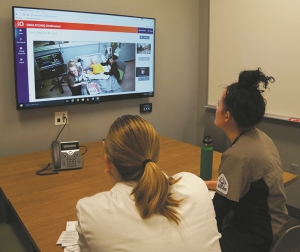Gillette College nursing student Amanda Killian had never been so nervous. Working with nursing
instructor Julie Guernsey in the new Simulation, or SIM Center, Amanda
was inserting a tube into the nose of a young patient who had accidentally
taken an unknown medication. A heart monitor was displaying vital signs
and Amanda talked through what she was doing while referring to a set
of laminated cards on the bed beside her. Two other nursing students,
Amy Schmitz and Rachael Peterson, watched Amanda closely on a video monitor
in an adjacent room.
Amanda wasn’t working with an actual child, but a special teaching
mannequin that can simulate many different illnesses and medical abnormalities.
Teaching simulation labs like this one at the new Gillette College Pronghorn
Center aren’t that unusual, but are new to Gillette. This kind of
teaching provides a controlled environment that imitates a real-life setting,
so students master skills without putting patients at risk.
“This feels more real than a lecture,” says Amanda. “I
can really put my training to use.”
 The students take turns working with the simulation mannequins in specific
treatment scenarios and watch each other on video.
The students take turns working with the simulation mannequins in specific
treatment scenarios and watch each other on video.
They can see if the skills are performed correctly, take notes if anything
was missed, and have their own chance to practice.
The mannequins are really advanced computerized machines with realistic
anatomy that can simulate a seizure, heart attack, or even childbirth.
“I won’t forget the mistakes I made on my patient,” said
Amy. “It helps that we’re being watched by our teachers and
peers.”
Gwen Reed, nursing instructor and simulation facilitator agrees. Gwen,
a registered nurse and paramedic, is responsible for keeping all the pieces
of the sim lab running smoothly.
“Our students could go through all four semesters of clinical experience
at the hospital and not see an actual delivery," said Gwen. “In
the sim lab they can see everything from a normal delivery to a mom and
baby with complications. When you do something over and over the muscle
memory kicks in and you can react without thinking.”
While the Gillette College nursing program will use the sim lab every week
while school is in session, it will be used by other healthcare groups
as well. Campbell County Health contributed $500,000 toward the equipment
in the sim lab, and is developing training opportunities for nursing and
EMS personnel.
“Hands-on training has proven to be an effective way to learn new
skills. The more time you practice clinical skills the better prepared
you are for a real life situation," says Deb Tonn, Vice President
of Patient Care Services at CCH. “We’re looking forward to
using the lab to help clinical staff practice and perfect their skills
in an environment where patients can’t be harmed.”
Interested in a career in nursing?
Over a million new nurses will be needed in the United States by 2022.
Gillette College offers an Associate Degree in Nursing (ADN) and nursing students can begin
courses toward their Bachelor of Science Degree in Nursing (BSN) concurrently.
This is made possible through a partnership with the
University of Wyoming. Call the Gillette College Nursing program at 307-686-0254, ext. 1200 or email
epridgeon@sheridan.edu to learn more visit
www.Sheridan.edu
Photos:
- Nursing student Amanda Killian works with nursing instructor Julie Guernsey,
RN, in a simulation scenario.
- Students Rachael Peterson and Amy Schmitz observe a simulation in real time.